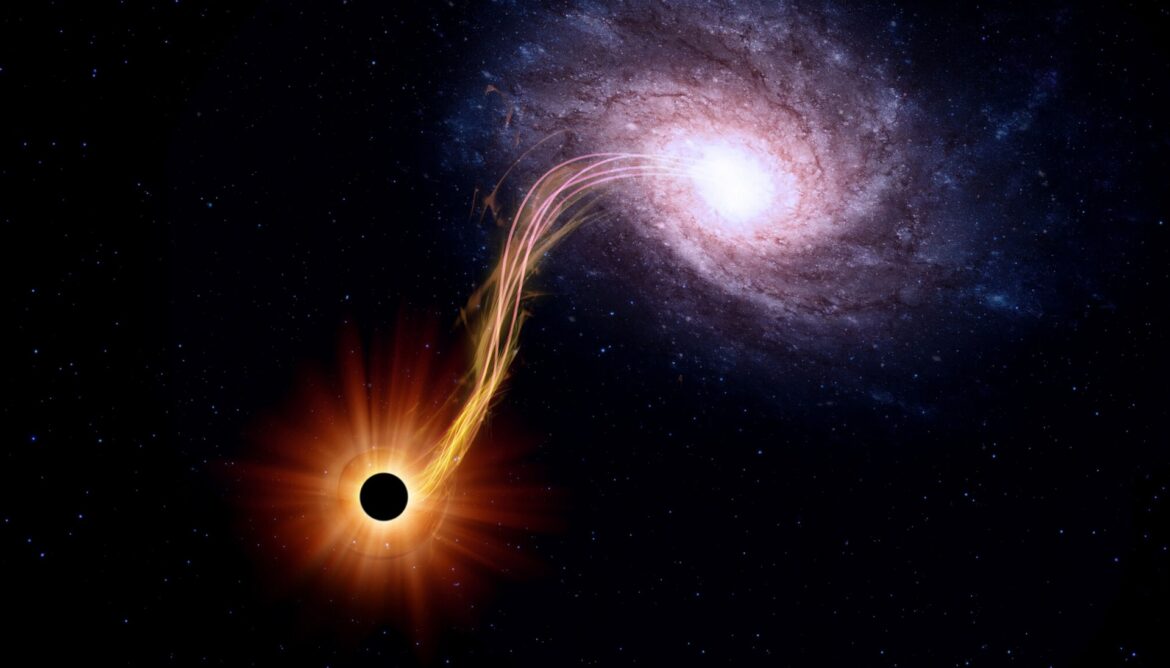In a monumental discovery on 13 July 2025, scientists announced the detection of the most massive black hole merger ever observed. Using gravitational-wave observatories, the Laser Interferometer Gravitational-wave Observatory (LIGO) team recorded the signal from two black holes—each over 100 times the sun’s mass—colliding to form a single, colossal black hole estimated at around 225 times the sun’s mass. This record-breaking event challenges established theories about black hole formation and opens new frontiers in astrophysics.
Understanding Gravitational Waves & Black Hole Mergers
Gravitational waves are ripples in spacetime produced by massive accelerating bodies, like merging black holes. First predicted by Einstein’s theory of general relativity in 1916, they were directly detected by LIGO in 2015 (the famous GW150914 event)Science News+11The Guardian+11Gizmodo+11.
Black hole mergers occur when two black holes orbit each other, spiral in, and fuse in a violent cosmic collision. These events emit powerful gravitational waves, allowing observatories like LIGO, Virgo, and KAGRA to detect them across billions of light years.
The GW231123 Event: What Happened
- Detection date: 23 November 2023 (though results were released in July 2025)Phys.org+2Wikipedia+2The Guardian+2
- Source: About 10 billion light years away
- Progenitor masses: ~103 M☉ and ~137 M☉, both spinning extremely fast (~400,000× Earth’s spin)Interesting Engineering+3The Guardian+3SSBCrack News+3
- Final black hole: ~225 M☉ — significantly larger than the previous record of 140 M☉ (GW190521)Wikipedia+10Phys.org+10EurekAlert!+10
- Signal duration: Roughly 0.1 seconds, corresponding to the “ringdown” phaseWikipedia+5The Guardian+5SSBCrack News+5
Despite occurring billions of years ago, the event was only picked up recently thanks to advances in detection sensitivity during LIGO-Virgo-KAGRA’s fourth observing runGizmodo+8Phys.org+8EurekAlert!+8.
Why GW231123 Matters
1. It Challenges Formation Theory
Under standard stellar evolution, black holes within the mass gap (60–130 M☉) aren’t expected to form. The mass of the components of GW231123 clearly falls within and above this range, suggesting they likely formed from prior mergersThe Guardian+12Science News+12Wikipedia+12.
2. Extreme Spin
Both black holes spin near the theoretical limit prescribed by relativity. Such rapid rotation further supports the “hierarchical merger” hypothesis, where earlier collisions impart angular momentumGizmodo.
3. Technological Breakthrough
Detecting such short-duration, high-mass events required upgraded waveform models and instrumentation to interpret intricate spinning dynamicsSSBCrack News.
What It Means for Physics and Astronomy
Rethinking Black Hole Origins
GW231123 reveals that black holes can be built up cumulatively through successive mergers. This supports theories involving dense star clusters or active galactic nuclei disks, where repeated collisions are possible.
Testing General Relativity
Such extreme events offer fresh tests of relativity under conditions previously unobserved. Deviations in signal shape could hint at new physics.
Future Detection Potential
As detectors grow more sensitive, the discovery of intermediate- and super-massive black hole mergers becomes more probable—ushering in a true gravitational-wave astronomy eraThe Guardian+1Space+1.
Broader Trends & Impacts
- Detector synergy: LIGO (USA), Virgo (Italy), KAGRA (Japan) now coordinate more closely, expanding detection reachScience News+8Phys.org+8California Institute of Technology+8.
- Astronomy paradigm shift: We’re transitioning from electromagnetic-only observations to multi-messenger cosmic studies.
- Stimulating theoretical work: Astrophysicists worldwide are racing to explain how such massive black holes can form within cosmic history.
Practical Implications & The Future
While not directly affecting everyday life, this discovery shapes:
- Future observatories: Projects like LISA (space-based gravitational wave detector) will build on these findingsGizmodoEurekAlert!+8Ground News+8The Guardian+8Wikipedia.
- Astrophysics education: Universities, including UK institutions like Cardiff and Birmingham, are updating curriculums to reflect these results.
- Public interest in science: This kind of cosmic milestone often galvanizes public support and funding for fundamental research.
Frequently Asked Questions
- What is GW231123?
A gravitational wave event from a black hole merger detected on 23 November 2023, released July 2025 dataSpaceCourthouse News+11Wikipedia+11Gizmodo+11. - Why is it the ‘most massive’?
The resulting black hole—~225 M☉—eclipses the previous top mass of 140 M☉Interesting Engineering+3SSBCrack News+3Ground News+3The Guardian+1Space+1. - What is the mass gap?
A theorised range (60–130 M☉) where black holes shouldn’t form via typical stellar collapseScience News+1Interesting Engineering+1. - Why does spin matter?
High spin suggests a dynamic merger history and increases the complexity of waveformsWikipedia+2Science News+2EurekAlert!+2. - When and where will further details be released?
Scientists will present refined analyses at the GR-Amaldi conference in Glasgow in mid‑July 2025Space+5The Guardian+5SSBCrack News+5. - Can Earth detect more such events soon?
Yes—as detectors improve, the frequency of recorded events may rise dramatically. - What’s next in gravitational-wave research?
LIGO/Virgo/KAGRA will continue observing into Run O4 and beyond, with planned enhancements increasing reach and fidelity.
Final Thoughts
GW231123 isn’t just another discovery—it’s a paradigm shift. With its unprecedented mass and spin, this black hole collision challenges current astrophysical theories and pushes the boundaries of observational technology. As gravitational-wave astronomy matures, we’re likely to confront even more astonishing cosmic events—deepening our understanding of the universe and our place within it.
Internal Links from The Breadline Bulletin
- Beginner’s Guide to Investing in the UK (2025): How to Start with Just £50
- Trump’s 30% Tariffs Shake Global Markets, Hit UK Stocks
- “From Idea to Reality: How to Launch a Startup in the UK (2025 Edition)”
- 10 Must‑Know Startup Strategies for UK Entrepreneurs in 2025
- UK Heatwave Triggers Record Wildfires and Emergency Water Bans in 2025
Resources & References
- The Guardian: Scientists detect biggest ever merger of two massive black holes GizmodoScience News+8EurekAlert!+8Phys.org+8Gizmodo+4The Guardian+4Wikipedia+4
- Phys.org (Caltech/LIGO summary)
- Science News: Extreme black hole collision challenges physics models Science News+1Wikipedia+1
- Courthouse News Centre coverage Courthouse News
- Wikipedia: GW231123 overview California Institute of Technology+3Wikipedia+3Gizmodo+3
- EurekAlert science release EurekAlert!+1EurekAlert!+1
Disclaimer
All information is based on publicly available scientific reports as of 14 July 2025. Further updates may arise from proceedings at the GR-Amaldi conference and peer-reviewed publications. This article is for educational purposes and does not offer scientific advice.
SEO Meta Info
SEO Title: Record “Forbidden” Black Hole Merger Detected – GW231123 Explained
Slug: record-black-hole-merger-gw231123-2025
Meta Description: Scientists have observed the most massive black hole merger ever — two black holes merging into a 225-solar-mass giant. Discover what it means for physics and gravitational-wave astronomy.



